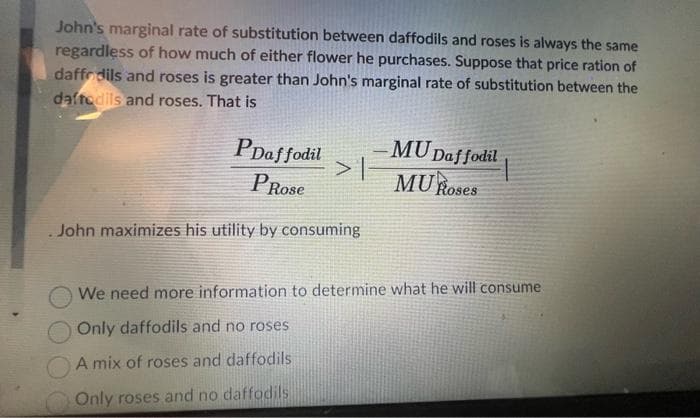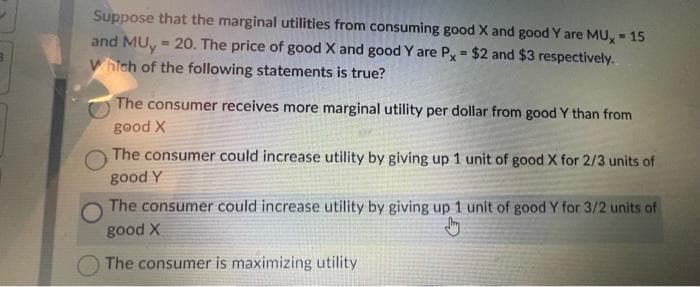John's marginal rate of substitution between daffodils and roses is always the same regardless of how much of either flower he purchases. Suppose that price ration of daffodils and roses is greater than John's marginal rate of substitution between the daffodils and roses. That is PDaffodil PRose > | . John maximizes his utility by consuming MU Daffodil MU Roses We need more information to determine what he will consume Only daffodils and no roses A mix of roses and daffodils Only roses and no daffodils
John's marginal rate of substitution between daffodils and roses is always the same regardless of how much of either flower he purchases. Suppose that price ration of daffodils and roses is greater than John's marginal rate of substitution between the daffodils and roses. That is PDaffodil PRose > | . John maximizes his utility by consuming MU Daffodil MU Roses We need more information to determine what he will consume Only daffodils and no roses A mix of roses and daffodils Only roses and no daffodils
Chapter4: Utility Maximization And Choice
Section: Chapter Questions
Problem 4.12P
Related questions
Question

Transcribed Image Text:John's marginal rate of substitution between daffodils and roses is always the same
regardless of how much of either flower he purchases. Suppose that price ration of
daffodils and roses is greater than John's marginal rate of substitution between the
daffodils and roses. That is
PDaffodil
PRose
> |
.John maximizes his utility by consuming
MU Daffodil
MU Roses
We need more information to determine what he will consume
Only daffodils and no roses
A mix of roses and daffodils
Only roses and no daffodils

Transcribed Image Text:Suppose that the marginal utilities from consuming good X and good Y are MU, -15
and MUy = 20. The price of good X and good Y are Px = $2 and $3 respectively.
Which of the following statements is true?
The consumer receives more marginal utility per dollar from good Y than from
good X
The consumer could increase utility by giving up 1 unit of good X for 2/3 units of
good Y
The consumer could increase utility by giving up 1 unit of good Y for 3/2 units of
good X
Jy
The consumer is maximizing utility
Expert Solution
This question has been solved!
Explore an expertly crafted, step-by-step solution for a thorough understanding of key concepts.
Step by step
Solved in 4 steps with 1 images

Knowledge Booster
Learn more about
Need a deep-dive on the concept behind this application? Look no further. Learn more about this topic, economics and related others by exploring similar questions and additional content below.Recommended textbooks for you







Economics (MindTap Course List)
Economics
ISBN:
9781337617383
Author:
Roger A. Arnold
Publisher:
Cengage Learning

Exploring Economics
Economics
ISBN:
9781544336329
Author:
Robert L. Sexton
Publisher:
SAGE Publications, Inc
